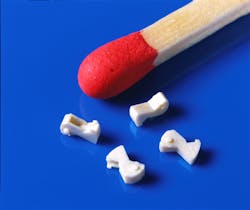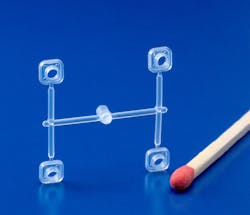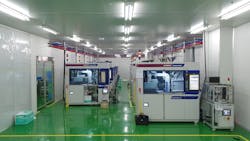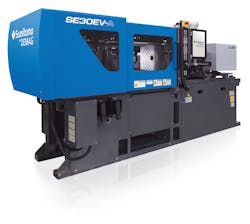OEMs take unique approaches to downsizing
By Karen Hanna
Micromolding isn’t just molding made smaller.
From the resins — sometimes injected a pellet at a time — to the final part— often smaller than the tip of a pen — the process requires the utmost control, with tolerances written several spaces to the right of any decimal.
Machinery OEMs differ on their exact definitions of a micromolded part or microstructure — a teeny feature on a part of any size — but agree that precision and repeatability are key to the process. Important considerations include strategies for feeding resin and controlling the melt; protecting material from degradation and parts from contamination; and matching the mold to the machinery.
“I always say if you think you’re a good molder, try to run a part that’s less than a gram,” said Chuck Alexander, national sales manager for Boy Machines.
Doubling down on going small
“Micromolding was always a niche market, but what we see is that this niche is growing from year to year,” said Martin Philipp-Pichler, the product manager for Wittmann Battenfeld’s MicroPower line of presses.
Joe Kendzulak is a senior technical adviser for Nissei, which has supplied machines to a molder that makes tiny medical suture tacks.
“They come out, you have to go right underneath the microscope to see them,” he said.
And it isn’t just the medical industry that’s stuffing more functionality in smaller parts, industry officials said.
“As technology and the IoT evolve and everyday devices get ‘smarter,’ we’re also seeing a lot of growth again in electronics and automotive due to the large numbers of sensors with very intricate features and connectors,” said Tony Marchelletta, theRichard Heckbert, a plastics engineer for Wittmann Battenfeld, listed a broad array of micromolded parts: fiber-optics connectors; surgical tools; implantable medical devices; components for the communications and electronics industries, including parts for cell phones, cameras and batteries; and automotive parts, such as micro gears, motors and valves. Also in demand are electrical connectors for the aerospace, defense and computer industries.
In the U.S., Fadi Abdal, VP of sales for Latin America, rest of world and global strategic accounts, said that, in the U.S.,manufacturers have been most focused on medical parts. "These customers come to Milacron based on our offerings in basic to advanced clean-room systems, medical systems with automation, and LSR systems. However, for global manufacturers specifically in Asia, we’ve observed increased demand for micromolded parts for electronics."
The pandemic provides one snapshot of micromolding’s growing place in the market both nationally and globally. For example, while other manufacturers were left reeling, Boy Machines was ramping up, Alexander said. In addition to taking a direct role in making personal protective equipment, the company stayed busy filling orders for machines, including micromolders, enlisted in the fight against COVID-19.
“Since the pandemic, our demand has went way up,” Alexander said. “We didn’t miss a beat. Actually, we probably worked longer and harder during the quarantine period for the fact that it was all hands on deck.”
Staying on spec
Processors that serve the medical industry know there is no room for error. Micromolding only intensifies the pressure for perfection.
“When you try to implant plastics into the body, you’re talking about fractions of grams,” Alexander said.
Mold Hotrunner Solutions Inc. (MHS) GM Stefan von Büren used the same measurements to describe the molding parameters within the wheelhouse of his company’s M3 presses: “The smallest part [our machines] make is 1.3 milligrams, and the sweet spot is up to 150 milligrams.”
Micromolded parts are demanding, and the materials often are sensitive and expensive. It requires a gentle touch, patience and attention to detail.
“A lot of those materials are so expensive that you pretty much can’t have any waste,” Alexander said. While conventional molders might have silos filled with resin, he said some micromolders use just a coffee cup’s worth of material for a project — in a year.
To produce machines that can work within such miniscule margins of such precious material, OEMs have developed a variety of strategies.
Turning molding inside-out
Von Büren describes his company as a hot-runner specialist that happens to make machines, building them from the inside out. Its M3 presses produce direct-gated parts.
“Traditional hot runners, they want to split the melt flow again, again, again, which gives you a long flow length,” von Büren said. That increases melt residence time and exposes sensitive resins to damage.
Instead of employing a spiderweb of cold runners and sprues — all eventual waste and a potential source of part imperfections — MHS engineers its machines with built-in hot runners that provide total control over the heating of the melt from the injection nozzle to the cavity.
“So, what we have in our machine is we have the hot-runner end is actually on the righthand side of the platen, which is where the injection unit of the machine is,” he said, “and … our hot runner has nozzles like a traditional hot runner, but those nozzles are sticking through the stationary platen and go right into the mold, so the hot runner is part of the machine, or we call it the machine is part of the hot runner.”
To prevent shear, the machine uses an auger that pushes material forward but does not heat it. “In our auger, we only convey the melt forward and do not shear the melt,” he said. “We heat it just by the heater bands.”
The presses use MHS’ patented Isokor rheological technology, which conditions the plastic close to the gate to further minimize residence time and degradation.
“So, the innovation is that the hot runner ... can process the melt much more gently and degradation is greatly reduced,” von Büren said.
Embracing familiarity
Minimizing the risk of material degradation and eliminating sprues and flash are some of the objectives in the designs of micromolding machines offered by other OEMs, which describe the units in more conventional terms.
Though industry officials stressed that manufacturers of micro parts occupy a unique niche within molding, Boy Machines has a simple design philosophy: Go with what you know.
“When you’re looking at very high-end materials, some of the PEEKs, biodegradables, implantable materials, there’s zero room for error, so the more you can mimic a large tried-and-true injection molding machine, the better you are,” Alexander said.
Like other makers of micromolding presses, Boy Machines sought to eliminate waste from the process through direct gating of parts, “so what comes out of the machine is just the part itself, no runner, no sprue,” Alexander said.
According to Alexander, Boy Machines’ portfolio of XS, XS V and XXS injection molding machines offers exceptionally small reciprocating-screw presses — all the way down to clamping forces of 7 tons.
Ken Bush, a process engineer manager for the company, said that, rather than use a plunger, the company’s machines use a screw that ensures more homogeneous mixing and greater repeatability.
“There’s no dead spots. It’s first-in, first-out,” Alexander said.
The company’s smallest machine can be outfitted with an 8mm screw and 8mm plasticizing unit, which assures short residence times. The company’s presses can make adjustments to within 0.01 cubic centimeter.
Alexander said the machines can cut waste by as much as 90 percent — or more.
“You get that accuracy only with a reciprocating screw,” he said.
But reciprocating screw movement is just one of many available strategies.
“By eliminating the sprue,” he said, “we will have much shorter cycle times as the cooling time will be dictated by the part itself. We will also have great material cost savings as less material will be required without the need for a sprue.”
The company last updated its MicroPower line by offering users an optional arrangement called the CombiMould — the ability to set up two, side-by-side injection units to perform two-material processes such as LSR molding. The machines are available in both clean-room and standard versions with clamping forces of 6 tons and 17 tons. As part of its virtual Fakuma presence, accessible at www.fakuma-messe.de/en/fakuma-virtual/, Wittmann Battenfeld plans to show a clean-room work cell involving a 17-tonner. The press will run an eight-cavity mold to make retaining rings for miniature tubes for the medical industry. The parts weigh just 2 milligrams.
Wittmann Battenfeld’s design eliminates the discrepancies in melt cushion and cavity pressure that can arise when using a conventional check ring, Heckbert said.
Eliminating deviation
Nissei’s Kendzulak said micromolding can magnify issues caused by check rings.
Kendzulak said the company responded to trends in the medical industry when it first released the NPX7 Advance several years ago. It wanted to provide the market with a machine right-sized to molds that reflect the ever-growing complexity of medical parts.
“In medical molding, basically, what we’re seeing is a lot of people are building bigger molds with smaller shot sizes, so they’re making smaller, intricate parts with more intricate molds,” he said.
Increasingly, moving components, such as sliding cams and cores, release parts from “weird, crazy molds,” Alexander said. In some cases, increasingly sophisticated molds are replacing the need for two-shot or insert-molding processes, or post-production assembly of parts.
To accommodate bigger molds, Nissei’s NPX7 Advance micromolder has widely spaced tie bars. The machine can handle molds measuring 170mm by 155mm. In addition to surgical tacks, parts produced by Nissei machines include lab slides, diabetes-management devices and eye-pressure sensors.
Doing the impossible
“Molders are more frequently being asked to do the nearly impossible,” Sumitomo‘s Marchelletta said. “Oftentimes, they are given a drawing of a micro-sized part that has never been molded or proven that it is even feasible to mold. So, it’s important that the machine have a number of specialized processing and [quality-control] capabilities that can be utilized to support their likelihood of success,” he said.
Though bigger than some other presses, Sumitomo’s new SE30V-A is “ideally suited for micromolding,” he said. It takes its place as the company’s smallest machine in its SEEV-A line.
The company equips its machines with a variety of innovations to handle the rigors of micromolding, according to Marchelletta. Among the most important is its Intelligent Screw Control II (ISC) and an optional screw technology, called Spiral Logic (SL).
The second-generation ISC II is featured on the SE30V-A. It works with Sumitomo-built, third-generation, direct-drive servomotors for injection and plasticizing “to ensure the exceptionally fast-response screw control and process stability that micromolding requires,” Marchelletta said.
In addition to the FFC and ISC II, Sumitomo offers its SL screw packages designed for precise resin dosing — even pellet by pellet. The technology achieves even movement of the resin through the barrel, and like technologies offered by other companies, it pushes melt into mold cavities in a first-in, first-out sequence. A non-return valve blocks backflow.
“The result is that a homogeneous melt and stable process are maintained, and uncontrolled shear heating, material stagnation/degradation, random short shots and black spots are virtually eliminated,” Marchelletta said. “Additionally, barrel wear, carbonization and maintenance requirements are reduced.”
Asserting control
The press itself isn’t the only consideration for micromolders. Other issues include the mold, the molding environment and part handling.
At Milacron, Abdal said personnel work with customers on all the technologies they'll need to make the end part they want. "This is not only for the injection molding machine, but also a full systems approach with automation to streamline the process," he said.
The company's headquarters in Ohio provides space for customers to run trials, and Milacron works with other specialists,such as Robert Barr Inc., an Osted, Mich.-based maker of plasticating screws, to help molders complete their projects. "For example, Barr Screws helps our customers tackle challenging plastics processing applications. This technology also helps to provide faster melting and better energy efficiency," he said.
The company's Roboshot machines with clamping forces from 17 tons to 33 tons are appropriate for micromolding. Milacron's machines can mold thermoplastic parts with shot sizes as small as 8 milligrams shot size and LSR parts with shot sizes half that size.
Taking a full-process perspective, with control over all the variables, is as strategy for many micromolders, OEM representatives said.
“We’ve seen some micromolders actually going back to the basics, where it’s like one cavity so they have complete control over their product where you’re talking about one part comes out and goes right underneath the microscope,” Nissei’s Kendzulak said.
Taking control — from pellet to final part — is essential, he and other OEM representatives said, especially when it comes to the tracking and tracing required by customers in the medical industry and other demanding markets.
To address those concerns, OEMs touted their latest machine controllers, offering more data tracking ability than ever.
As a supplier of both primary and auxiliary equipment, Wittmann Battenfeld distinguishes itself in offering a greater degree of control over the entire molding process, Philipp-Pichler said.
“Compared to other machinery suppliers, we adapt the machine, as well as all the peripheral equipment for micromolding,” he said. “It's much more than just shrinking a standard setup to small dimensions like other suppliers do.”
In addition, OEM officials also stressed the importance of cleanliness in the design of machines often employed to make functional parts for delicate applications.
Nissei markets both its hydraulic and electric presses to micromolders. The question of which is more appropriate often is simply a matter of preference, company representatives said.
“In general, all-electric machines are considered ‘clean’ since they do not use hydraulic oil,” said Mac Otsuka, marketing manager for Nissei America. “However, Nissei hybrid-type machines run as clean as the all-electric machines since the flow of hydraulic oil is minimum, thanks to the X-Pump System,” Nissei’s oil-on-demand hydraulic pump system.
Because they feature fewer moving parts, hydraulic machines often require less maintenance than electric models — meaning fewer people are coming into contact with equipment that might be producing clean-room parts, Kendzulak said.
“I have medical molders. Now, they may order five machines from us; three may be electric, two may be hydraulic,” he said.
Finding your fit
Ultimately, buyers of primary machines define what a micromold is — and the definitions vary.
“If somebody is molding car doors, and starts molding Bic pens, that’s micromolding to them,” Bush, of Boy Machines, said.
But, as he and others in the industry pointed out, it’s an illusion to think micromolding is just taking a part and shrinking it.
Molders that produce parts that are bigger or smaller than their press was designed to accommodate can experience inefficiencies — a fact that Boy Machines considered when it launched its own line of tiny presses, Alexander said.
“Before, what had happened is when parts like that were needed, they were run on larger presses, where you would have 5 percent yield on good parts and 95 percent waste,” he said. “So, we identified the market of well, how can we switch that around? How can we get 95 percent yield and 5 percent waste, or smaller?”
Bush, Alexander and other industry representatives stressed that even the best equipment won’t perform ideally when it comes to running molds better-suited for larger or smaller presses. Out of necessity, though, the Boy Machines officials said some molders continue to try.
As an example, Bush described trying to run a part requiring 0.2mm of material with a screw sized for an 80mm shot. “By the time it starts to move, it’s done, so you need to get something in that has a very small shot size, small screw and barrel, so you don’t have the material degrading and burning, plus you get the full function of what the machine’s meant to do.”
Trying to make micro parts on more conventional, large-volume machines is like owning a hot-rod for suburban driving, Alexander said. “We always use the analogy of taking a Ferrari through a housing development, right? So, you can only go 25 mph. A Ferrari doesn’t run so well at 25 mph because it’s supposed to go 200.”
Finding the perfect fit for a micro part is a big deal. Size very much matters. The right match is borne out in microns.
“You know when your machine is [running] right, when you can collect 20 consecutive parts, and then you can just throw them on a scale to see what the weight variation is. And that variation is out four, five decimal places [in] accuracy,” Bush said.
Karen Hanna, associate editor
Contact:
Boy Machines Inc., Exton, Pa., 610-363-9121, www.boymachines.com
MHS, Georgetown, Ontario, 905-873-1954, www.mhs-hotrunners.com
Milacron llc, batavia, ohio, 513-536-2000, www.milacron.com
Nissei America Inc., Anaheim, Calif., 714-693-3000, www.nisseiamerica.com
Sumitomo (SHI) Demag, Strongsville, Ohio, 440-876-8960, www.sumitomo-shi-demag.us
Wittmann Battenfeld Inc., Torrington, Conn., 860-496-9603, www.wittmann-group.com
About the Author
Karen Hanna
Senior Staff Reporter
Senior Staff Reporter Karen Hanna covers injection molding, molds and tooling, processors, workforce and other topics, and writes features including In Other Words and Problem Solved for Plastics Machinery & Manufacturing, Plastics Recycling and The Journal of Blow Molding. She has more than 15 years of experience in daily and magazine journalism.
Bruce Geiselman
Senior Staff Reporter Bruce Geiselman covers extrusion, blow molding, additive manufacturing, automation and end markets including automotive and packaging. He also writes features, including In Other Words and Problem Solved, for Plastics Machinery & Manufacturing, Plastics Recycling and The Journal of Blow Molding. He has extensive experience in daily and magazine journalism.





